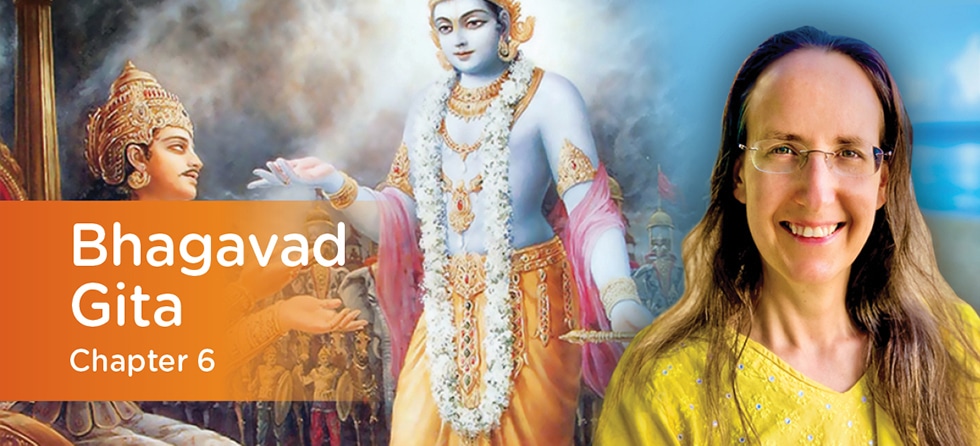- LIVE ONLINE PROGRAM
February 9 – April 6, 2021
Bhagavad Gita Chapter 6: The Yoga of Meditation
Rukmini Chaitanya
9 WEEKLY SESSIONS, Tuesdays, 7:00-8:30pm EST
What you'll learn:
- How to prepare the mind for meditation through karma yoga and cultivation of Sattva in daily life
- The importance of solitude, the posture, the meditation seat, and how to control the breath
- Cultivation of fearlessness, calmness, and purity as pre-requisite for meditation
- The importance of Mitahara: moderation in eating, sleeping, and recreation
- The lamp in a windless spot – the analogy to the mind of a meditator
- The meditation technique – how to control the mind
- The mind is likened to the wind – is it truly possible to control it?
- What happens to a fallen yogi, who leaves the body before accomplishing the goal?
- Why the Bhakta, the lover of God, the highest meditator?
We hear a lot about the benefits of meditation, and we know how indispensable it is for attaining Self-realization and spiritual liberation. And yet, it is so hard to control the mind. In the Bhagavad Gita, Arjuna, the mightiest warrior of his time and the great devotee and friend of Lord Krishna, had the same problem. He felt that it is easier to control the wind than the mind.
In the Gita, Lord Krishna, full of compassion, is teaching Arjuna (and through him to us) how to meditate. He gives practical tips, techniques, and preparations that are required for success in meditation. He explains the importance of the renunciation of desires and the need for solitude. He describes the meditation seat and postures and how a moderate lifestyle is conducive to successful meditation. He emphasizes practice and dispassion and reassures us that no effort is wasted in the path of yoga. Finally, he shares the message that the greatest yogi, or meditator, is the Bhakta — the lover of God.
Join us for this inspiring and practical course and learn how to deepen your meditation practice by following the instructions of Lord Krishna, the Supreme Being Himself.
Additional Information:
Offered as 9 weekly sessions on Tuesdays, Feb 9, 16, 23, Mar 2, 9, 16, 23, 30 & Apr 6, 7:00-8:30pm ET
This program is offered live through Zoom webinar with the availability for students to interact through Q&A with the presenter.
For enrolled students, a video recording will be available after each class in the event you miss a class or would like to review the content.
It is possible to register and take the course at any time. You can catch up on any classes you miss with the recordings.
Requirements and Recommendations:
- No experience necessary. This program is open to beginners as well as advanced practitioners.
- Viewing Device: Desktop or laptop computer will provide the best experience, although you can also connect via a tablet or smartphone.
- Internet connection: High-speed broadband wired or wireless is best.
- Video: Download Zoom to your computer, or install the Zoom app to your device. For interactive group sessions, a webcam or integrated camera will allow others to feel more connected with you.
- Audio: Headphone speakers are recommended. If you wish to participate vocally, a headset with a microphone will be ideal.
Course Includes:
- 10.5 hours of on-demand video
- Bhagavad Gita – translation and commentary by Swami SivanandaΩ
- Course Manual

Rukmini Chaitanya
Rukmini Chaitanya is a senior staff member of the Sivananda Ashram Yoga Retreat Bahamas, and the personal assistant to Swami Swaroopananda, the Acharya, or spiritual director of the Ashram. She regularly teaches the Bhagavad Gita during the Sivananda Yoga Teacher training as well as other courses on the Bhagavad Gita, Vedanta, positive thinking, meditation, and yoga philosophy.
Rukmini Chaitanya is known for her enthusiastic and inspiring teaching style as well as for her devotion to the lineage and the scriptures. She is dedicated to each of her students and has an innate desire to share knowledge with them. She brings a great deal of clarity to every topic and is highly appreciated for her capacity to unfold complicated topics and present them in a coherent and pure way.
